PONTIAC BONNEVILLE 1995 Manual PDF
Manufacturer: PONTIAC, Model Year: 1995, Model line: BONNEVILLE, Model: PONTIAC BONNEVILLE 1995Pages: 338, PDF Size: 16.19 MB
Page 71 of 338
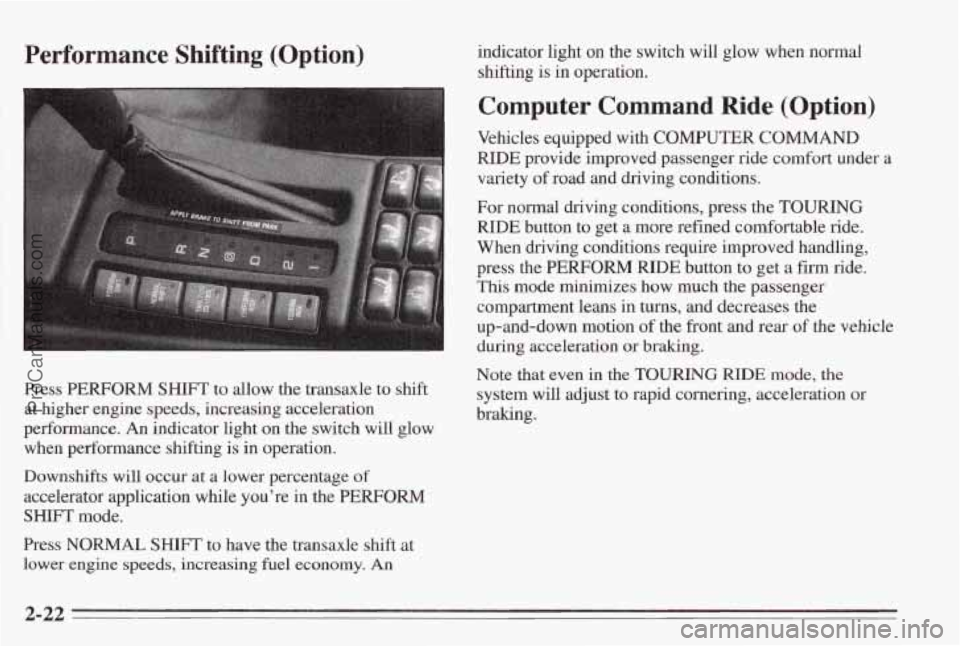
Performance Shifting (Option)
Press PERFORM SHIFT to allow the transaxle to shift
at higher engine speeds, increasing acceleration
performance. An indicator light on
the switch will glow
when performance shifting is in operation.
Downshifts will occur at a lower percentage of
accelerator application while you’re in the
PERFORM
SHIFT mode.
Press NORMAL
SHIFT to have the transaxle shift at
lower engine speeds, increasing fuel economy. An
indicator light on the switch will glow when normal
shifting
is in operation.
Computer Command Ride (Option)
Vehicles equipped with COMPUTER COMMAND
RIDE provide improved passenger ride comfort under a
variety of road and driving conditions.
For normal driving conditions, press the
TOURING
RIDE button to get a more refined comfortable ride.
When driving conditions require improved handling,
press the
PERFORM RIDE button to get a firm ride.
This mode minimizes how much the passenger
compartment leans in turns, and decreases the
up-and-down motion
of the front and rear of the vehicle
during acceleration or braking.
Note that even in the TOURING RIDE mode, the
system will adjust to rapid cornering, acceleration or
braking.
2-22
ProCarManuals.com
Page 72 of 338
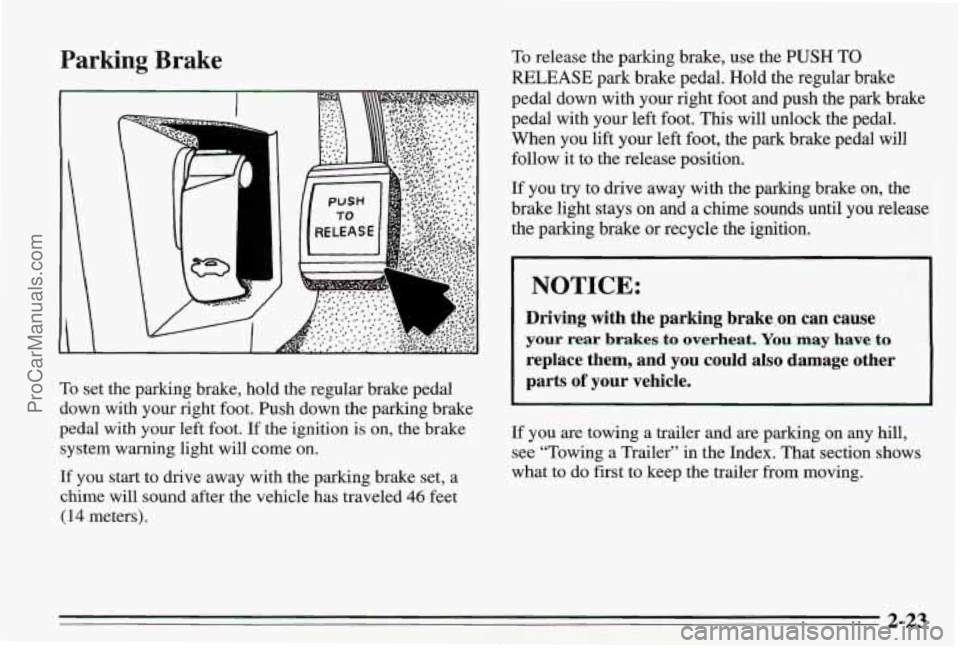
Parking Brake
A
To set the parking brake, hold the regular brake pedal
down with your right foot. Push down the parking brake
pedal with your left foot.
If the ignition is on, the brake
system warning light will come on.
If you start to drive away with the parking brake set, a
chime
will sound after the vehicle has traveled 46 feet
(14 meters). To
release the parking brake, use the
PUSH TO
RELEASE park brake pedal. Hold the regular brake
pedal down with your right foot and push
the park brake
pedal with your left foot. This will unlock the pedal.
When you lift your left foot, the park brake pedal
will
follow it to the release position.
If you try to drive away with the parking brake on, the
brake light stays on and a chime sounds until you
release
the parking brake or recycle the ignition.
I NOTICE:
Driving with the parking brake,on can cause
your rear brakes to overheat. You may have to
replace them, and you could also damage other
parts
of your vehicle.
If you are towing a trailer and are parking. on any hill,
see “Towing a Trailer” in the Index. That section shows
what to do first to keep the trailer
from moving.
2-23
ProCarManuals.com
Page 73 of 338
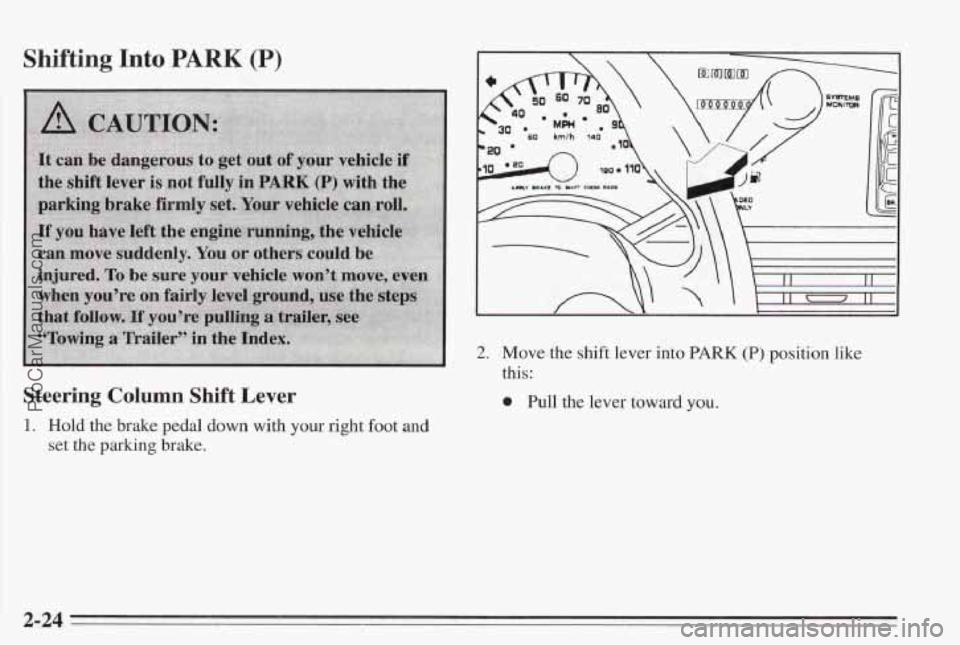
Shifting Into PARK (P)
Steering Column Shift Lever
1. Hold the brake pedal down with your right foot and
set the parking brake.
3a '60 km/h 140
II I I1
2. Move the shift lever into PARK (P) position like
this:
0 Pull the lever toward you.
2-24
ProCarManuals.com
Page 74 of 338
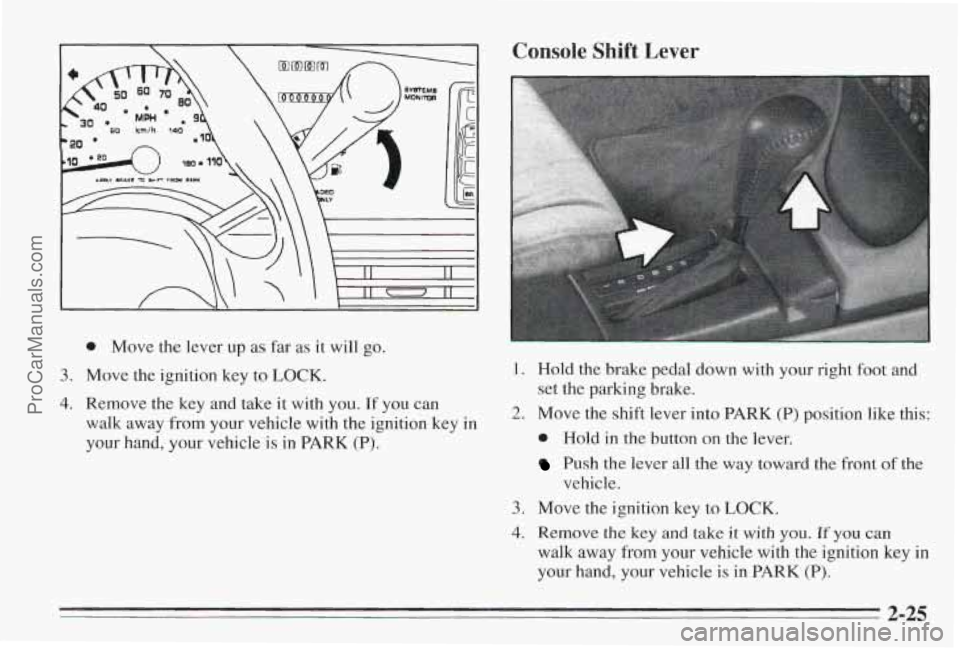
0 Move the lever up as far as it will go.
3. Move the ignition key to LOCK.
4. Remove the key and take it with you. If you can
walk away from your vehicle with the ignition key in
your hand, your vehicle
is in PARK (P).
Console Shift Lever
1. Hold the brake pedal down with your right foot and
2. Move the shift lever into PARK (P) position like this:
set the parking brake.
0 Hold
in the button on the lever.
Push the lever all the way toward the front of the
vehicle.
3. Move the ignition key to LOCK.
4. Remove the key and take it with you. If you can
walk away from your vehicle with the ignition key in
your hand, your vehicle is in PARK (P).
2-25
ProCarManuals.com
Page 75 of 338
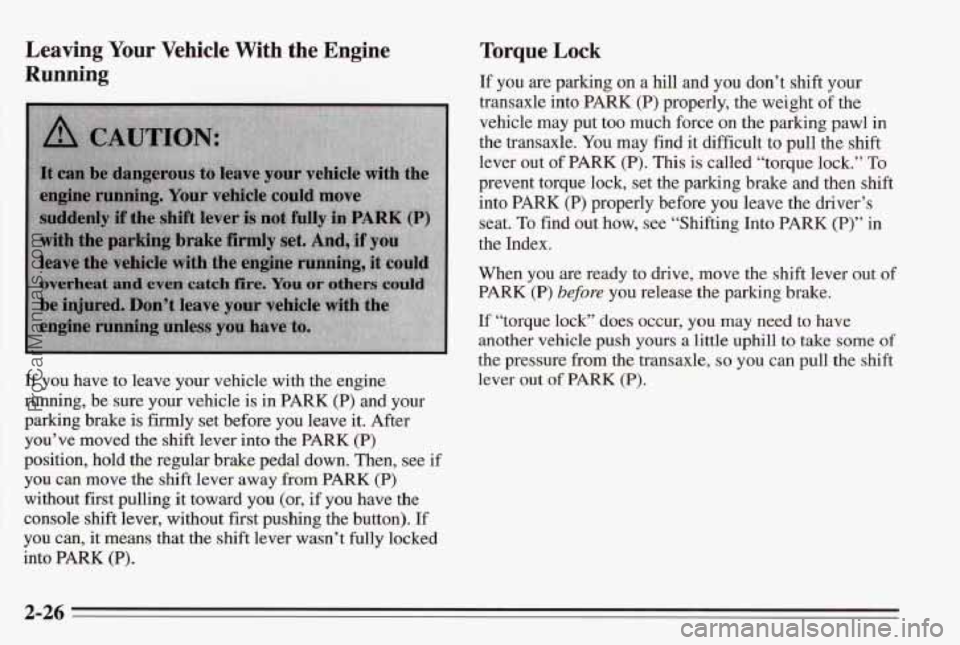
Leaving Your Vehicle With the Engine
Running
If yon have to leave your vehicle with the engine
running,
be sure your vehicle is in PARK (P) and your
parking bralae is fdy set before you leave it. After
you’ve moved the shift lever into the PARK (I?)
position, hold the regular brake pedal down. Then, see if
you can muve the shift lever away from PARK (P)
without first pulling it tow& you (or, if you have the
console shift lever, without first pushing.the button). If
yuu c-an, it mema that the shift lever- w&snB t fully locked
into PARK (P).
Torque Lock
If you are parking on a hill and you don’t shift your
transaxle into
PARK (P) properly, the weight of the
vehicle may put too much force on the
parking pawl in
the transaxle. You may find it difficult to pull the shift
lever out
of PARK (P). This is called “torque lock.” To
prevent torque lock, set the parking brake and then shift
into
PARK (P) properly before you leave the driver’s
seat.
To find out how, see “Shifting Into PARK (P)” in
the Index.
When
you are ready to drive, move the shift lever out of
PARK
(P) before you release the parking brake.
If “torque lock” does occur, you may need to have
another vehicle
push yours a little uphill to take some of
the pressure from the transaxle. so you can pull the shift
lever out of PARK (P).
2-26
ProCarManuals.com
Page 76 of 338
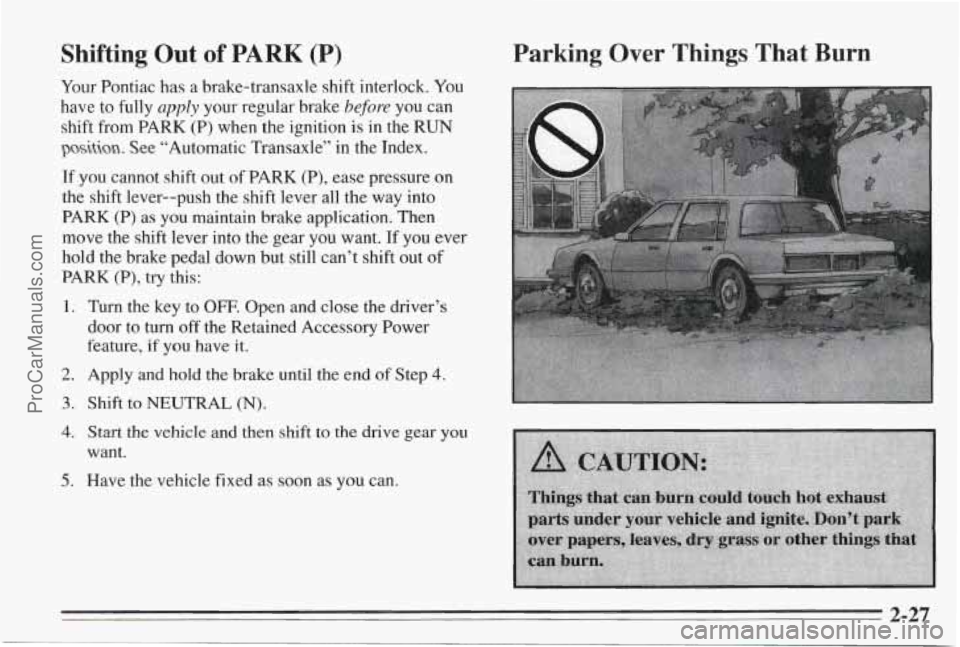
Shifting Out of PARK (P)
Your Pontiac has a brake-transaxle shift interlock. You
have to fully
apply your regular brake before you can
shift from PARK (P) when the ignition
is in the RUN
pition. See “Automatic Transaxle” in the Index.
If you cannot shift out of PARK (P), ease pressure on
the shift lever--push the shift lever all the way into
PARK (P) as you maintain brake application. Then
move the shift lever into the gear you want. If you ever
hold the brake pedal down but still can’t shift out
of
PARK (P), try this:
1. Turn the key to OFF. Open and close the driver’s
door to turn
off the Retained Accessory Power
feature,
if you have it.
2. Apply and hold the brake until the end of Step 4.
3. Shift to NEUTRAL (N).
4. Start the vehicle and then shift to the drive gear you
want.
5. Have the vehicle fixed as soon as you can.
Parking Over Things That Burn
2-27
ProCarManuals.com
Page 77 of 338
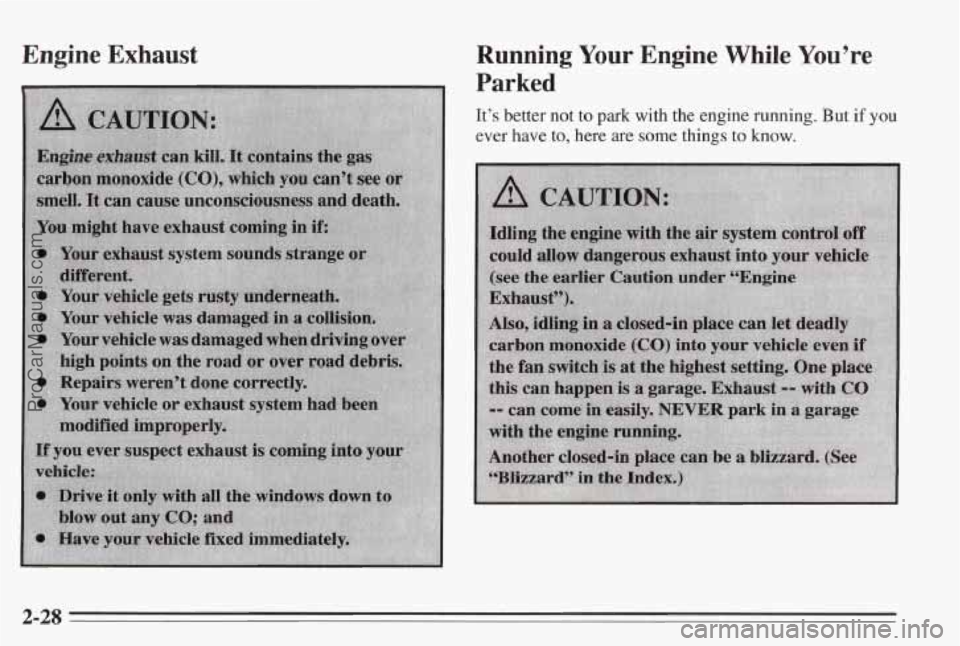
Engine Exhaust Running Your Engine While You’re
Parked
It’s better not to park with the engine running. But if you
ever have to, here are some things to know.
2-28
ProCarManuals.com
Page 78 of 338
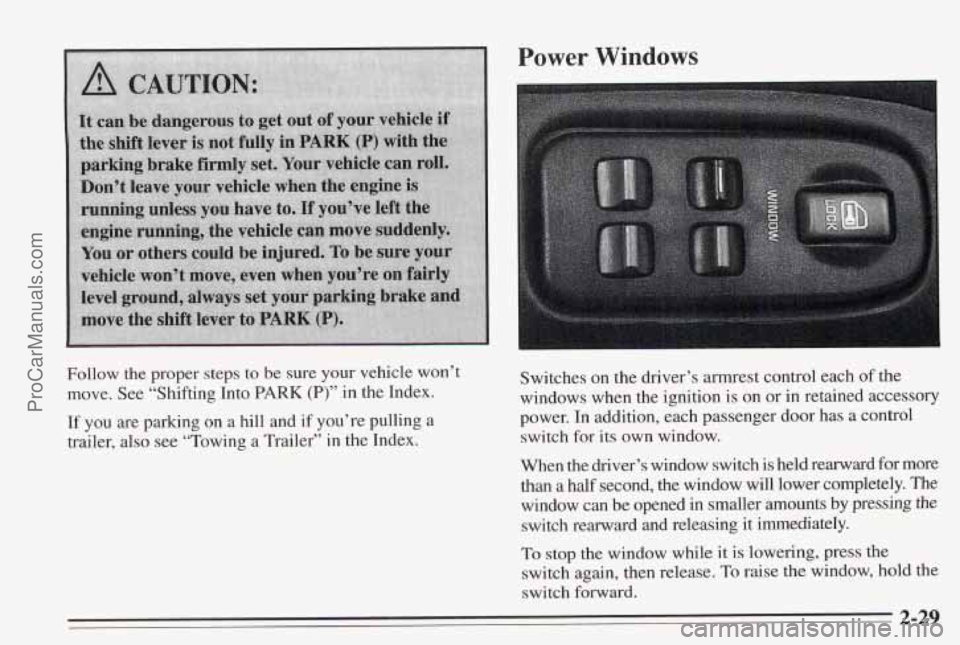
Power Windows
Follow the proper steps to be sure your vehicle won’t
move. See “Shifting Into
PARK (P)” in the Index.
If you are parking on a hill and if you’re pulling a
trailer, also
see “Towing a Trailer” in the Index. Switches on
the driver’s armrest control each
of the
windows when the ignition is on or in retained accessory
power. In addition,
each passenger door has a control
switch for its
own window.
When the driver’s window switch
is held rearward for more
than a half second, the window will lower completely. The
window
can be opened in smaller amounts by pressing the
switch rearward and releasing
it immediately.
TO stop the window while it is lowering, press the
switch again, then release. To raise
the window, hold the
switch
forward.
2-29
ProCarManuals.com
Page 79 of 338
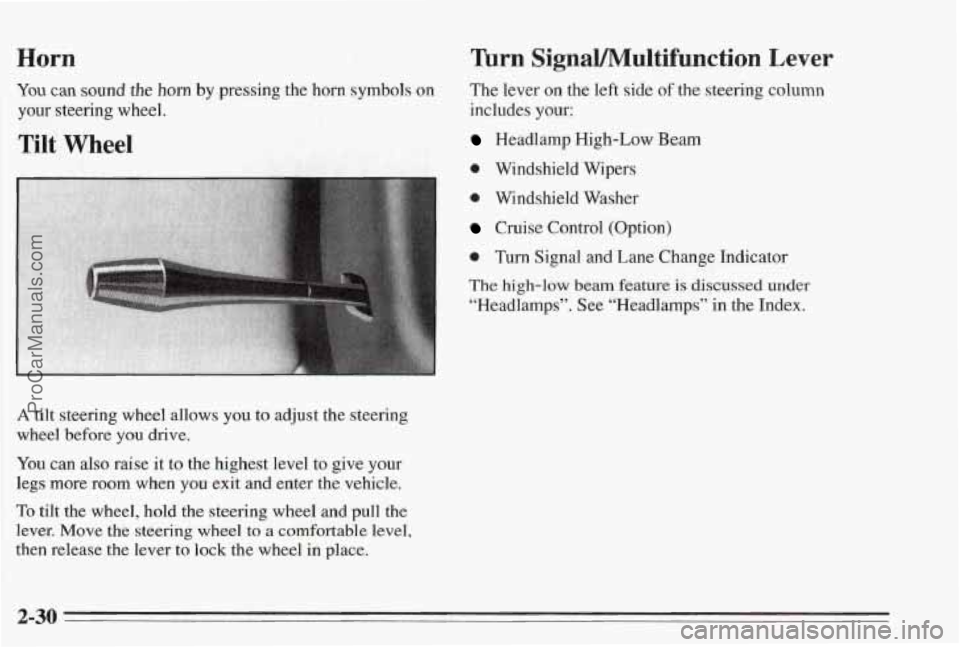
Horn
You can sound the horn by pressing the horn s’ymbols on
your steering wheel.
‘Tilt Wheel
Turn SignaVMultifunction Lever
The lever on the left side of the steering column
includes your:
Headlamp High-Low Beam
0 Windshield Wipers
a Windshield Washer
Cruise Control (Option)
@ Turn Signal and Lane Change Indicator
The high-low beam feature is discussed under
“Headlamps”. See “Headlamps” in the Index.
A tilt steering wheel allows you to adjust the steering
wheel before you drive.
You can
also raise it to the highest level to give your
legs more room when you exit and enter the vehicle.
To tilt the wheel, hold the steering wheel and pull the
lever.
Move the steering wheel to a comfortable level,
then release the lever to
lock the wheel m place.
2-30
ProCarManuals.com
Page 80 of 338
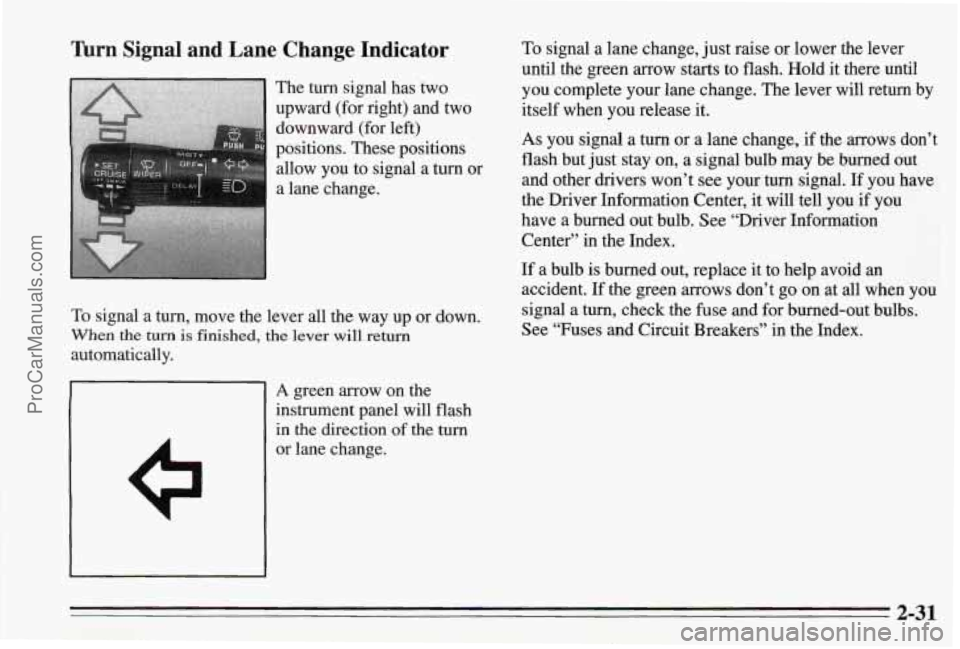
Turn Signal and Lane Change Indicator
The turn signal has two
upward (for right) and two
downward (for
left)
positions. These positions
I
allow you to signal a turn or
a lane change.
To signal a turn, move the lever all the way up or down.
When the turn is finished, the lever will return
automatically.
A green arrow on the
instrument panel will flash
in the direction of the turn
or lane change.
To signal a lane change, just raise or lower the lever
until the green arrow starts to flash. Hold it there until
you complete your lane change. The lever will return by
itself when you release it.
As you signal a turn or a lane change, if the arrows don’t
flash but just stay on, a signal bulb
may be burned out
and other drivers won’t see your turn signal. If you have
the Driver Information Center, it will tell you
if you
have a burned out bulb. See “Driver Information
Center” in the Index.
If a bulb is burned out, replace it to help avoid an
accident. If the green arrows don’t go on at all when you
signal a turn, check the fuse and for burned-out bulbs.
See “Fuses and Circuit Breakers” in the Index.
2-31
ProCarManuals.com